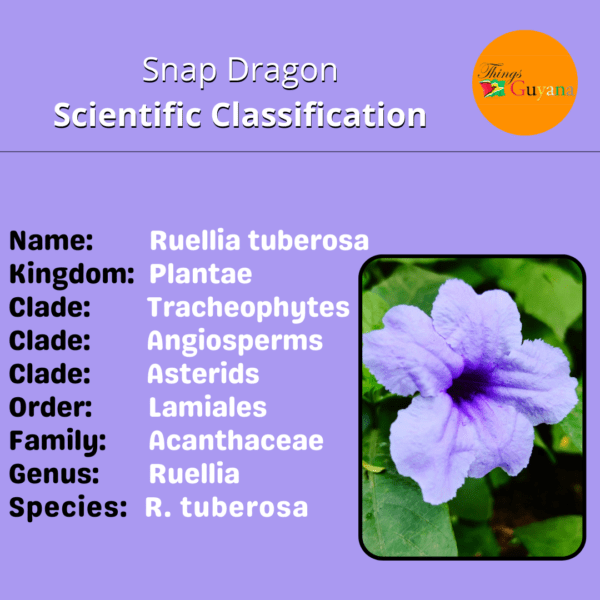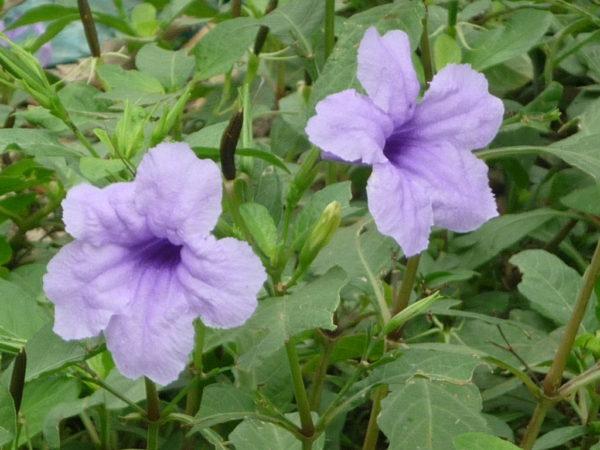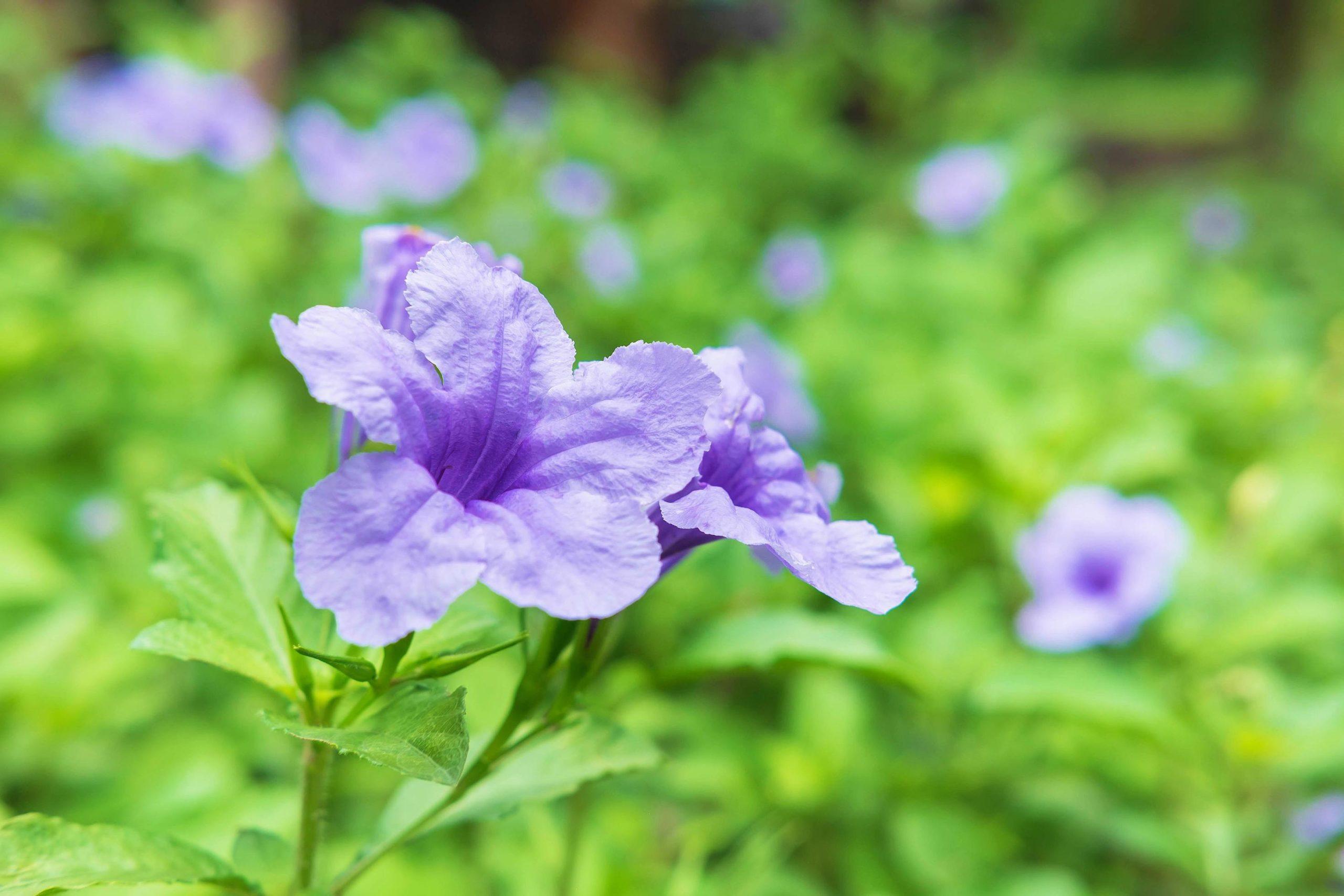Have you ever noticed a lovely, purple, bell-shaped flower growing outside or maybe in someone’s yard? I used to always assume that these flowers were bluebells but they’re actually known as ‘Ruellia’. Continue reading to find out more about these beautiful, violet flowers and how to grow your own!

Description

Photo of Ruellia Tuberosa. Photo Source: https://www.flickr.com/photos/binh-minh/5623057739
It is a small biennial plant with thick tuberous, cylindrical, and finger-like roots and striking funnel-shaped violet coloured flowers. Leaves are oblong-obovate and hairless on both sides (4-8 cm long, 1.5-4.2 cm wide). The leaf margin is undulated to approximately the entire (smooth edges). Leaves are arranged oppositely along the stem. Stems are 4-sided and hairy. The flowers are Pale blue to purple, and trumpet-shaped flowers are 2.2 to 5.5 cm wide with 5 approximately round, overlapping lobes (1.6 cm long, 1.5 cm wide). Dry dehiscent fruits are known as capsules (1.8-2.5 cm long, 0.3-0.4 cm wide). Dark brown, cylindrical pods are pointed at the tip and hairless except for glandular trichomes at the tip. When a mature pod becomes wet, it opens with explosive dehiscence, catapulting the 7-8 disk-shaped seeds into the air.
Habitat
These plant can be found in disturbed sites, waste areas. Its native range is in Central America but presently it has become naturalized in many countries of tropical South and Southeast Asia.
Uses
Ruellia Tuberosa has been used as part of folk medicine for many years. It has been traditionally claimed to be used for the treatment of flu, asthma, fever, bronchitis, high blood pressure, eczema, and diabetes Some of the countries that make use of this plant are:
- Suriname – Considered a traditional medicine, used as anthelmintic; for joint pains and muscle strain. Also used as abortifacient. Root is used against kidney diseases and whooping cough. Infusion used for cleansing the blood. Root and leaf used for alleviating urinary retention. Used for gonorrhea, syphilis, bladder stones, bronchitis and cancer.
- Grenada – It is used for common colds, fevers and hypertension.
- Trinidad and Tobago – It is used as a “cooling” agent and for urinary problems and high cholesterol.
- India – Used for kidney stone disorders and applied to scorpion bites.
The whole parts of genus Ruellia are used in bladder stones and in bronchitis. Paste of leaves is also used for skin diseases and boils. Roots are used as anthelmintic. Syrup is used for whooping cough. Tuber powder is used for stomach ache.
Antinociceptive / Anti-Inflammatory: Ethanol extract of Ruellia tuberosa showed antinociceptive and anti-inflammatory activities. The anti-inflammatory activity was comparable to that of indomethacin (a medication used for swelling and to relieve pain).
Gastroprotective and analgesic activity: It was reported that aqueous extract of Ruellia tuberosa roots showed a strong and dose dependent gastroprotective activity.
How to Grow Rubellia Tuberosa
- An ideal location for growing ruellia is a site with full sun exposure. Although ruellia flowers are highly adaptable and may do well in shade, expect fewer blooms due to the lack of sunlight. Growing ruellia plants will appreciate regular water but, again, the tolerant plant can withstand drought conditions in prepared soil.
- Remove any frost damaged foliage to prevent any further damage or insipient disease. An ideal location for growing ruellia is a site with full sun exposure.
- In terms of soil, Wild Petunia prefers to grow in soil that is average dry to medium moisture. It is essential to provide the plant with well-draining soil.
- Ruellia plants like to grow in relatively moist soil, not soggy soil. So, it is essential to water your Ruellias regularly. It would be best to water your Ruellias every 2-3 days in summer and reduce watering to once a week in the cold season. After they establish, Ruellia plants become drought tolerant.
References
- https://www.nparks.gov.sg/florafaunaweb/flora/2/4/2404
- https://en.wikipedia.org/wiki/Ruellia_tuberosa
- https://www.gardeningknowhow.com/ornamental/flowers/ruellia/growing-ruellia-wild-petunias.htm#:~:text=Growing%20ruellia%20plants%20will%20appreciate,self%2Dseeding%2C%20rampant%20growth.
- https://www.ptfarm.pl/pub/File/Acta_Poloniae/2015/5/821.pdf
- https://gardenbeast.com/wild-petunia-guide/#:~:text=Ruellia%20plants%20like%20to%20grow,Ruellia%20plants%20become%20drought%20tolerant.







